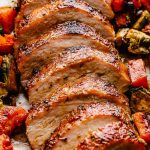 After the French came from Normandy in 1066 and conquered England, they decided that they would be the ones who ate the animals, while the defeated English would be the ones who raised the animals. Accordingly, most of the original English animal names—such as pig, cow, calf, sheep, and deer—continued to be used in the barnyard, but French names—such as pork, beef, veal, mutton, and venison—were given to meats once they appeared on the table. The French pore was borrowed as pork at the beginning of the fifteenth century; the French in turn had developed the word from the Latin porcus, meaning hog. This Latin word is also the source of several other English animal names, including porcupine, literally meaning thorny pig, and porpoise, literally meaningfish pig. Porcelain, the fine china brought out for special meals, also derives its name from the Latin word for pig: the Latin porcus gave rise to the Italian porca whose diminutive, meaning little pig, is porcella. This word, porcella, was given by the Italians to a seashell because its shape and contours resembled, in their minds, the external genitalia of female pigs. The name of this seashell was then borrowed by the French as porcelaine, which they bestowed upon the fine china because its sheen and colour resembled that of the shell. It was this word that English borrowed, without the final e, at the beginning of the sixteenth century.
After the French came from Normandy in 1066 and conquered England, they decided that they would be the ones who ate the animals, while the defeated English would be the ones who raised the animals. Accordingly, most of the original English animal names—such as pig, cow, calf, sheep, and deer—continued to be used in the barnyard, but French names—such as pork, beef, veal, mutton, and venison—were given to meats once they appeared on the table. The French pore was borrowed as pork at the beginning of the fifteenth century; the French in turn had developed the word from the Latin porcus, meaning hog. This Latin word is also the source of several other English animal names, including porcupine, literally meaning thorny pig, and porpoise, literally meaningfish pig. Porcelain, the fine china brought out for special meals, also derives its name from the Latin word for pig: the Latin porcus gave rise to the Italian porca whose diminutive, meaning little pig, is porcella. This word, porcella, was given by the Italians to a seashell because its shape and contours resembled, in their minds, the external genitalia of female pigs. The name of this seashell was then borrowed by the French as porcelaine, which they bestowed upon the fine china because its sheen and colour resembled that of the shell. It was this word that English borrowed, without the final e, at the beginning of the sixteenth century.
Meat from a pig.
The flesh of the swine consumed in its unprocessed state, in contrast to the cured forms of bacon and ham. The most exquisite pork originates from youthful creatures, distinguishable by its sleek and delicate skin, resilient musculature, and pale fat.
